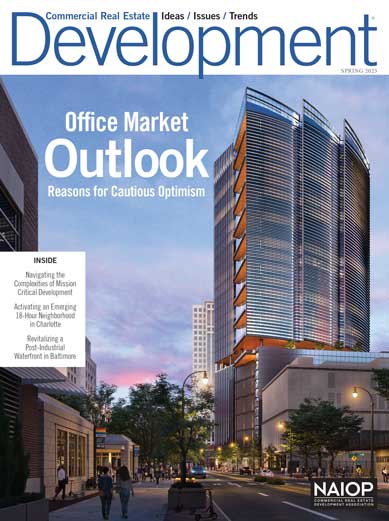Summer 2022 Issue
Transforming an Abandoned Brownfield into a Modern Cold Storage Facility
By: Kenneth E. Rodman, Jr.A public-private collaboration results in an $84 million investment and more than 80 new jobs in Portsmouth, Virginia.
Last Mile: The Most Challenging Piece of the Logistics Puzzle
By: Jeffrey SmallInfill development in high-value locations can be a complex process.
A 'Calming Presence' at the Helm
By: Trey BarrineauThomas J. Bisacquino, NAIOP’s long-serving president and CEO, retires after three decades with the association.
Download the Summer 2022 Issue of Development
Download a PDF version of the Summer 2022 Issue of Development.
Must-Read Articles

Operation Zero Waste: A Greener Way to Take Out the Trash

A Triple-Whammy Threatens Project Viability

Vacant Storefronts Can be Repurposed into Retail Incubators

The Unexpected Challenges (and Solutions) of Multilevel Warehouse Design

Mitigating Environmental Risks in Life Science Leases

When Retail and Industrial Merge

Industrial Market Analysis: Measuring Where to Invest

Parking in a Post-Pandemic Economy
RELATED RESEARCH AND PUBLICATIONS
From Static to Strategic: AI’s Role in Next-Generation Industrial Real Estate
Industrial Space Demand Forecast, Third Quarter 2025
Economic Impacts of Commercial Real Estate in Canada, 2025 Edition
PERSPECTIVES
From the Editor: A Job Well Done
CEO on Leadership: Meg Epstein
Chapter Profile NAIOP Raleigh Durham
- Perspectives,
- Career,
- ...
ADDITIONAL ARTICLES
Biden Wetlands Regulation May Be Upended by Supreme Court
A Fresh Look at Office Conversions
The Growing Demand for Supplier Diversity in the Commercial Real Estate Industry
Hybrid Goals? Reinventing the Office, Faster and Better Than Before
- Coworking,
- Logistics,
- ...
How RFIs and Change Orders Disrupt Multifamily Development Projects
Reducing Financial Risks for the Lender on Projects
New & Noteworthy
ARCHIVED ISSUES
View All Archived Issues Summer 2025 Issue
Summer 2025 Issue
Development’s summer 2025 issue explores experiential retail and the brick-and-mortar resurgence. Also featured: a modern warehouse campus in Toronto that honors its manufacturing heritage; a coalition of Oregon real estate organizations working to revitalize downtown Portland; and the creative capital stack strategy behind a mixed-use project in West Baltimore.
 Spring 2025 Issue
Spring 2025 Issue
The spring 2025 issue offers insights about where the office market might be heading over the coming year, explores the complexities of mission critical development, and provides detailed looks at two transformative mixed-use projects: The Bowl at Ballantyne in Charlotte and Baltimore Peninsula in Maryland.
 Winter 2024/2025 Issue
Winter 2024/2025 Issue
Development magazine’s winter issue delves into the evolving uses of artificial intelligence in the commercial real estate industry, from lease management and building operations to portfolio assessment and data analysis.
















